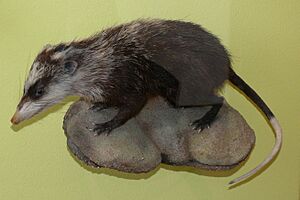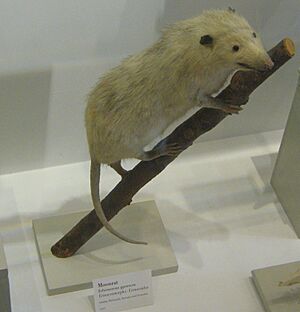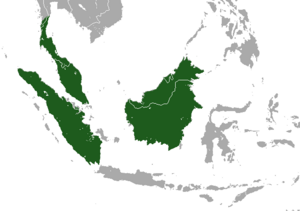Moonrat facts for kids
Quick facts for kids Moonrat |
|
|---|---|
 |
|
 |
|
| Museum specimens of the two moonrat subspecies: E. g. gymnura (above) |
|
| Conservation status | |
| Scientific classification | |
| Genus: |
Echinosorex
|
| Species: |
gymnura
|
 |
|
| Moonrat range | |
The moonrat (Echinosorex gymnura) is a cool mammal found in Southeast Asia. Even though it's called a "moonrat," it's actually not a rat at all! It's more closely related to hedgehogs and other animals called gymnures. This unique animal is the only species in its group, called Echinosorex. Moonrats are mostly meat-eaters and are fairly small.
Contents
What Does a Moonrat Look Like?
Moonrats have a very strong, unique smell, a bit like ammonia. It's different from the musky smell of other meat-eating animals.
There are two main types, or subspecies, of moonrats:
- E. g. gymnura: You can find this one in places like Sumatra and the Thai-Malay Peninsula. Its head and the front part of its body are usually white or gray-white, while the rest is mostly black.
- E. g. alba: This type lives in Borneo. It's generally white (alba means white in Latin), with a few black hairs. From a distance, it looks completely white.
Moonrats from western Borneo often have more black hairs than those from the east. However, moonrats from Brunei seem to be a mix. Sometimes, you might even see a mostly white E. g. gymnura, but they are rare.
A moonrat's body, from head to tail, is about 32–40 cm (13–16 in) long. Its tail adds another 20–29 cm (7.9–11.4 in). Their back feet are about 6.5–7.5 cm (2.6–3.0 in) long. They usually weigh between 870–1,100 g (1.92–2.43 lb). Moonrats might be the largest animals in their group, called Erinaceomorpha. However, the European hedgehog can sometimes weigh more, from 1,000 g (2.2 lb) up to 2,000 g (4.4 lb).
Where Do Moonrats Live and What Do They Eat?
Moonrats are active at night (this is called nocturnal). They live on the ground (this is called terrestrial). During the day, they hide under logs, tree roots, or in burrows that other animals have left.
They prefer to live in moist forests, including mangrove swamps and swamp forests. They often go into the water. In Borneo, they mostly stay in forests. But in peninsular Malaysia, you can also find them in gardens and plantations.
Moonrats mainly eat earthworms and other small animals. Their diet mostly includes arthropods, which are creatures like insects and spiders.
Lifespan
Moonrats can live for up to five years.
Conservation Status
The moonrat is not considered a threatened species right now. Its conservation status is "Least Concern" by the IUCN. This means they are not in immediate danger of disappearing.
However, there are some threats to moonrats. The biggest problem is deforestation. This happens when humans cut down forests for farming, plantations, and logging. Also, some local people, like the Penan in Borneo, hunt moonrats for food and traditional medicine. This can also lead to fewer moonrats in certain areas.
Luckily, moonrats can be found in protected areas. These include Matang National Park and Kuching Wetlands National Park. These parks help keep their homes safe.
Economic Importance
In the past, the Penan people in Borneo would trade moonrat meat. They would exchange it for other foods, goods, or even money.


